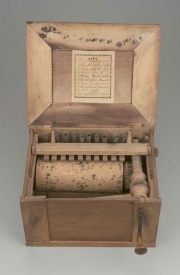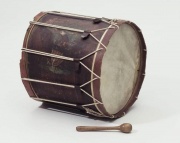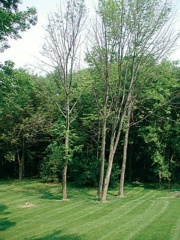Difference between revisions of "Ash (wood)"
(username removed) |
|||
| (6 intermediate revisions by 3 users not shown) | |||
| Line 1: | Line 1: | ||
| − | [[File:17.1943-SC34121.jpg|thumb|]] | + | [[File:17.1943-SC34121.jpg|thumb|Bird organ<br>MFA# 17.1943]] |
== Description == | == Description == | ||
Any of several hardwood ash trees from the family Oleaceae, genus ''Fraxinus''. Ash trees are widespread throughout the temperate regions of North America (white ash-''F. americana''; black ash-''F. nigra''; green ash-''F. pennsylvania''), Europe (common ash-''F. excelsior'') and Asia (Japanese ash-''F. mandschurica''; Chinese ash-''F. chinensis''). Ash trees produce distinctive growth rings with very large open pores followed by small, tight pores. The light-color, dense, elastic wood has a straight grain that is moderately durable but susceptible to insect attack and moisture degradation. The tough, heavy timber is used for ladders, tool handles, oars, poles, gymnasium equipment and hockey sticks because it produces a smooth surface that rarely splinters. Ash was also popular for furniture (especially colonial pieces), wheels, and carriage frames. | Any of several hardwood ash trees from the family Oleaceae, genus ''Fraxinus''. Ash trees are widespread throughout the temperate regions of North America (white ash-''F. americana''; black ash-''F. nigra''; green ash-''F. pennsylvania''), Europe (common ash-''F. excelsior'') and Asia (Japanese ash-''F. mandschurica''; Chinese ash-''F. chinensis''). Ash trees produce distinctive growth rings with very large open pores followed by small, tight pores. The light-color, dense, elastic wood has a straight grain that is moderately durable but susceptible to insect attack and moisture degradation. The tough, heavy timber is used for ladders, tool handles, oars, poles, gymnasium equipment and hockey sticks because it produces a smooth surface that rarely splinters. Ash was also popular for furniture (especially colonial pieces), wheels, and carriage frames. | ||
| + | [[File:1986.937a-b-SC14564.jpg|thumb|Bass drum<br>MFA# 1986.937]] | ||
| + | == Synonyms and Related Terms == | ||
| − | [[File: | + | white ash (''Fraxinus americana''); black ash (''Fraxinus nigra''); green ash (''Fraxinus pennsylvania''); common ash (''Fraxinus excelsior''); American ash; European ash; Japanese ash (''Fraxinus mandschurica''); Chinese ash (''Fraxinus chinensis''); frêne (Fr.); Esche (Deut.); frassino (It.); fresno (Esp.); freixo (Port.) |
| − | == | + | [[File:image 8-Ash_wood.jpg|thumb|Ash (wood)]] |
| + | ==Risks== | ||
| + | '''Links to Oddy Test results posted on AIC Wiki Materials Database Pages for individual materials below'''<br> | ||
| − | + | ° [http://www.conservation-wiki.com/wiki/Oddy_Test_Results:_Case_Construction_Materials#ash_wood0001 Ash Hardwood] Tested in 2016 | |
| − | == | + | ==Physical and Chemical Properties == |
| − | Light-color. Rings: distinct. Pores: coarse (in rings). Grain: distinct. Rays: obscure rays. Hard; heavy. | + | Light-color. Rings: distinct. Pores: coarse (in rings). Grain: distinct. Rays: obscure rays. Hard; heavy. All species look alike microscopically (Alden [https://wood-identification.com/wood-types/ Link]) |
{| class="wikitable" | {| class="wikitable" | ||
| Line 21: | Line 25: | ||
| specific gravity = 0.69 | | specific gravity = 0.69 | ||
|} | |} | ||
| − | |||
| − | |||
| − | |||
| − | |||
| − | |||
== Additional Images == | == Additional Images == | ||
| Line 34: | Line 33: | ||
</gallery> | </gallery> | ||
| + | == Resources and Citations == | ||
| + | * Schoch, W., Heller, I., Schweingruber, F.H., Kienast, F., 2004:[http://www.woodanatomy.ch/ Wood anatomy of central European Species]: English Ash,[http://www.woodanatomy.ch/species.php?code=FXEX Fraxinus excelsior L.] | ||
| − | + | * Alden Identification Services, Microscopic Wood Identification: [https://wood-identification.com/wood-types/ Link] | |
* R. J. Gettens, G.L. Stout, ''Painting Materials, A Short Encyclopaedia'', Dover Publications, New York, 1966 | * R. J. Gettens, G.L. Stout, ''Painting Materials, A Short Encyclopaedia'', Dover Publications, New York, 1966 | ||
| − | * ''Encyclopedia Britannica'', http://www.britannica.com Comment: "ash." | + | * ''Encyclopedia Britannica'', http://www.britannica.com Comment: "ash." Accessed 7 Apr. 2005 . |
* G.S.Brady, ''Materials Handbook'', McGraw-Hill Book Co., New York, 1971 Comment: p. 74 | * G.S.Brady, ''Materials Handbook'', McGraw-Hill Book Co., New York, 1971 Comment: p. 74 | ||
| Line 55: | Line 56: | ||
| − | [[Category:Materials database]] | + | [[Category:Materials database]][[Category:MWG]][[Category:Wood]] |
Latest revision as of 14:18, 3 March 2023
Description
Any of several hardwood ash trees from the family Oleaceae, genus Fraxinus. Ash trees are widespread throughout the temperate regions of North America (white ash-F. americana; black ash-F. nigra; green ash-F. pennsylvania), Europe (common ash-F. excelsior) and Asia (Japanese ash-F. mandschurica; Chinese ash-F. chinensis). Ash trees produce distinctive growth rings with very large open pores followed by small, tight pores. The light-color, dense, elastic wood has a straight grain that is moderately durable but susceptible to insect attack and moisture degradation. The tough, heavy timber is used for ladders, tool handles, oars, poles, gymnasium equipment and hockey sticks because it produces a smooth surface that rarely splinters. Ash was also popular for furniture (especially colonial pieces), wheels, and carriage frames.
Synonyms and Related Terms
white ash (Fraxinus americana); black ash (Fraxinus nigra); green ash (Fraxinus pennsylvania); common ash (Fraxinus excelsior); American ash; European ash; Japanese ash (Fraxinus mandschurica); Chinese ash (Fraxinus chinensis); frêne (Fr.); Esche (Deut.); frassino (It.); fresno (Esp.); freixo (Port.)
Risks
Links to Oddy Test results posted on AIC Wiki Materials Database Pages for individual materials below
° Ash Hardwood Tested in 2016
Physical and Chemical Properties
Light-color. Rings: distinct. Pores: coarse (in rings). Grain: distinct. Rays: obscure rays. Hard; heavy. All species look alike microscopically (Alden Link)
| Density | 40-53 ppcf |
|---|---|
| Molecular Weight | specific gravity = 0.69 |
Additional Images
Resources and Citations
- Schoch, W., Heller, I., Schweingruber, F.H., Kienast, F., 2004:Wood anatomy of central European Species: English Ash,Fraxinus excelsior L.
- Alden Identification Services, Microscopic Wood Identification: Link
- R. J. Gettens, G.L. Stout, Painting Materials, A Short Encyclopaedia, Dover Publications, New York, 1966
- Encyclopedia Britannica, http://www.britannica.com Comment: "ash." Accessed 7 Apr. 2005 .
- G.S.Brady, Materials Handbook, McGraw-Hill Book Co., New York, 1971 Comment: p. 74
- F. H. Titmuss, Commercial Timbers of the World, The Technical Press Ltd., London, 1965
- H.L.Edlin, What Wood is That?, Viking Press, New York, 1969
- Van Nostrand's Scientific Encyclopedia, Douglas M. Considine (ed.), Van Nostrand Reinhold, New York, 1976
- Random House, Webster's Encyclopedic Unabridged Dictionary of the English Language, Grammercy Book, New York, 1997
- CRC Handbook of Chemistry and Physics, Robert Weast (ed.), CRC Press, Boca Raton, Florida, v. 61, 1980 Comment: density=40-53 ppcf (0.65-0.85 g/cm3)




